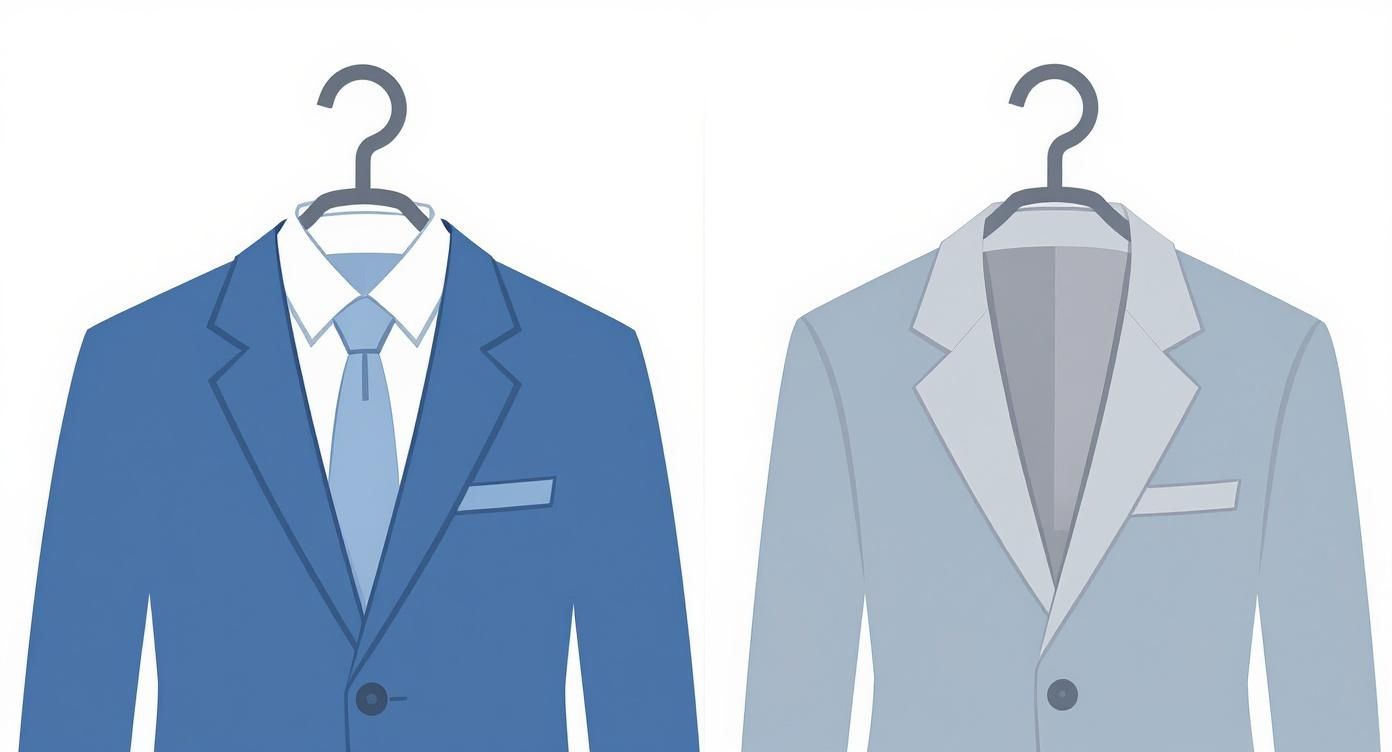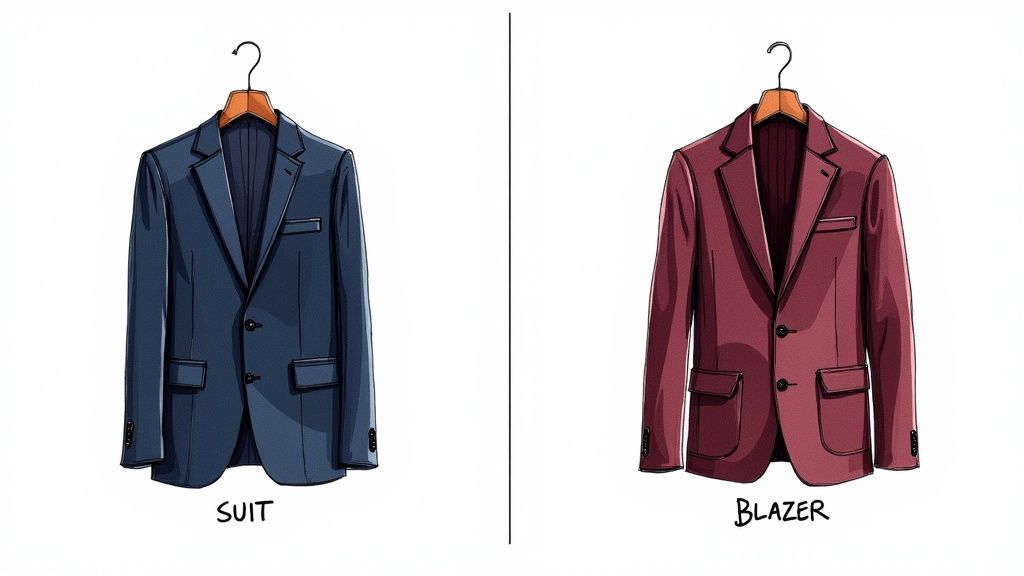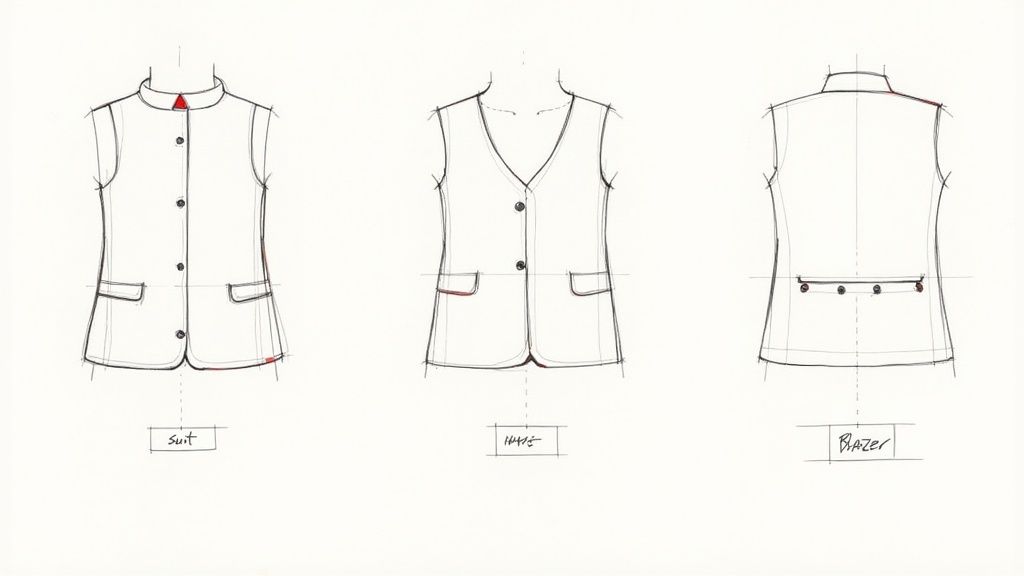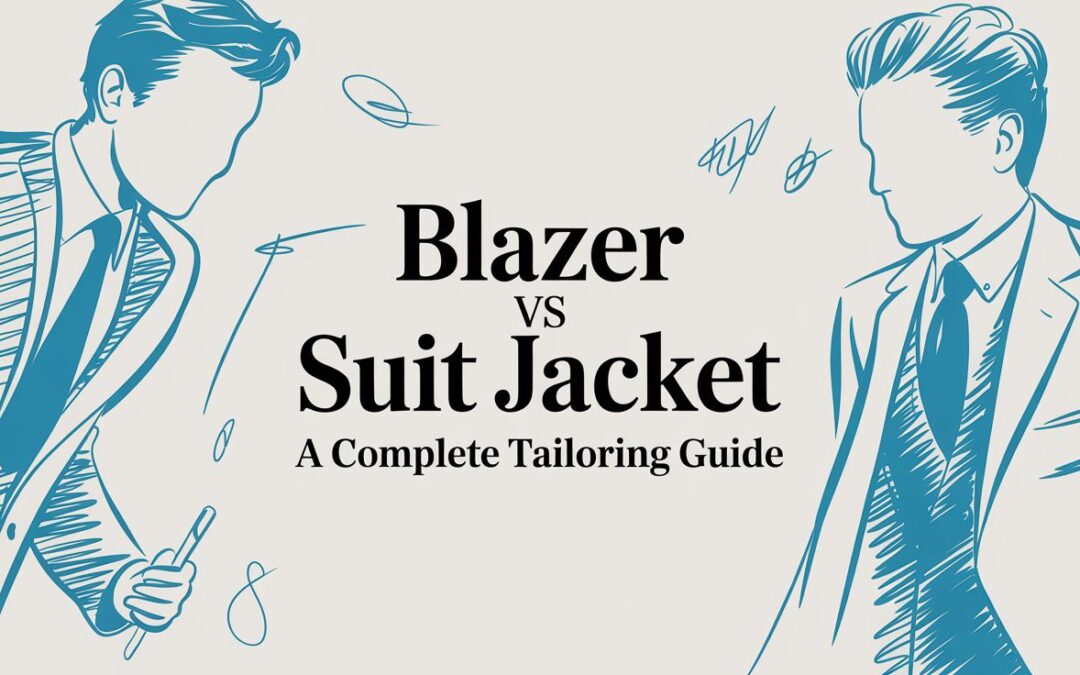When you’re trying to settle the blazer vs suit jacket debate, it really comes down to one thing: purpose. A suit jacket is born as part of a set, always intended to be worn with its matching trousers. Its fine fabric and more formal structure are designed for that specific pairing. A blazer, on the other hand, is a standalone piece. It's built from tougher, more textured fabrics and often has distinct details like contrasting buttons, making it a versatile wardrobe workhorse.
Key Takeaways
- A Suit Jacket Belongs to a Set: It is always made with matching trousers from the same fine, smooth fabric and should never be worn separately.
- A Blazer is a Standalone Garment: Designed to be worn with contrasting trousers, it features more textured, durable fabrics like hopsack or serge.
- Contrasting Buttons are a Key Blazer Feature: Blazers often have distinctive metal, horn, or mother-of-pearl buttons, while a suit jacket's buttons match its fabric.
- Formality is the Main Divider: Suit jackets are for formal and business occasions as part of a full suit. Blazers excel in smart-casual and business-casual settings.
Understanding the Key Differences
Knowing the difference between these two menswear staples is all about spotting a few key characteristics. While both jackets will give you a sharp silhouette, the way they're made, the fabrics used, and how you're meant to wear them set them on completely different style paths. Getting these nuances right is the first step to building outfits that are not just stylish, but truly appropriate for any occasion.
This visual breakdown gets straight to the point, showing the main distinctions between a suit jacket, which is all about formal uniformity, and a blazer, which is designed for standalone elegance.

As the graphic shows, a suit jacket’s identity is locked into its matching trousers. The blazer’s real strength is its freedom—its ability to be paired with everything from chinos and jeans to flannel trousers. To get an even clearer picture and bring another classic jacket into the mix, you might want to explore the difference between a sports coat and a blazer in our other detailed guide.
For a quick, at-a-glance comparison, this table breaks down the essential differences.
Blazer vs Suit Jacket Quick Comparison
Here’s a simple reference table that summarises the fundamental differences between a classic blazer and a traditional suit jacket. Think of it as your cheat sheet.
| Feature | Suit Jacket | Blazer |
|---|---|---|
| Matching Trousers | Yes, always worn as a set | No, designed to be worn with separates |
| Formality | High (Formal, Business) | Medium (Smart-Casual, Business-Casual) |
| Fabric | Smooth, fine weaves (e.g., worsted wool) | Textured, durable (e.g., hopsack, serge) |
| Buttons | Matching the fabric | Contrasting (e.g., metal, horn) |
| Structure | More structured shoulders and chest | Softer, more relaxed construction |
| Pockets | Formal (jetted or flapped) | Often more casual (patch pockets common) |
Ultimately, understanding these distinctions will help you make smarter choices when building your wardrobe, ensuring you have the right jacket for the right moment.
Tracing the Heritage of Each Garment
To really get to grips with the modern rules of the blazer versus suit jacket debate, you have to look at where they came from. Each garment was born from a specific need, and that history is woven into the very fabric of its design. Their individual stories explain exactly why one is part of an inseparable pair, while the other is celebrated for its independence.

The suit jacket is a product of 19th-century London, where Savile Row tailors crafted it as a sleeker, more practical alternative to the formal frock coats of the era. Crucially, it was always conceived as one half of a whole—the suit. This explains its fine fabric and structured design; its entire purpose was to create a uniform, polished look for business and formal events.
The Blazer: An Emblem of Independence
The blazer’s story, on the other hand, begins on the water. Its lineage traces back to the durable, double-breasted navy jackets worn by the British Royal Navy in the 1800s. These were designed first and foremost to be functional, smart, and resilient.
Another branch of its family tree grew from the colourful jackets worn by university rowing clubs, like the famous vibrant red jackets of Cambridge’s Lady Margaret Boat Club. These were garments meant to stand out and identify team members at a glance.
This dual heritage—one part military uniform, one part sporting attire—is precisely why the blazer thrives as a standalone piece. It was never meant to match anything but the spirit of the occasion.
This history directly informs its core characteristics today. The robust fabrics, contrasting buttons, and slightly more relaxed fit are all echoes of its past as a functional, versatile jacket designed to be worn on its own.
The key takeaway is simple. A suit jacket without its matching trousers looks incomplete because it is incomplete; it has lost its other half. A blazer, however, was born to be paired with separates, making it the quintessential choice for creating varied and sophisticated smart-casual looks. This fundamental difference in origin dictates their roles in a modern gentleman's wardrobe.
Comparing Fabric Weave and Garment Construction
Setting aside their different social histories for a moment, the real, tangible differences between a blazer and a suit jacket come down to two things: the cloth it's made from and how it's put together. A suit jacket is built for sleek, uniform elegance, whereas a blazer is designed for texture, durability, and the strength to stand on its own.
A suit jacket is almost always cut from a fine, smooth fabric like worsted wool. The aim here is to create a clean, fluid drape that looks like a single, unbroken line when worn with its matching trousers. The construction reflects this formality, typically being more rigid and structured with padded shoulders and a canvassed chest to sculpt a sharp silhouette.
Blazers, on the other hand, embrace more robust, characterful materials. Their construction is generally softer and less structured, often featuring a more natural shoulder line that allows for greater comfort and a relaxed feel. This fundamental difference in philosophy is why gentlemen who appreciate fine tailoring often explore different options for each garment. For a deeper dive into these nuances, our guide on made to measure vs bespoke offers some valuable insights.
The Role of Fabric Texture
The choice of fabric is the most immediate signal of a jacket’s intended purpose. Suit jackets depend on delicate, smooth weaves to achieve that luxurious feel and consistent appearance.
A blazer, however, is defined by its more interesting and hard-wearing cloths. These materials aren't just chosen for looks; they’re selected for their ability to pair beautifully with other fabrics without looking orphaned from a suit.
- Hopsack: A brilliant basket-weave fabric known for its breathability and natural crease resistance. This makes it an excellent choice for a versatile, year-round blazer.
- Serge: A durable twill fabric, most famously used for the classic navy blazer. Its hard-wearing nature and timeless look make it a true workhorse.
- Flannel: A wonderfully soft, milled cloth that brings warmth and a refined texture to the party, making it perfect for an autumn or winter blazer.
- Tweed: A rugged, woollen fabric steeped in rustic, country heritage. It’s the ideal choice for a more casual, sporting blazer or sport coat.
A blazer's fabric is its personality. The textured weave is intentionally chosen to create a slight, pleasing contrast with the trousers it's paired with, whether they're smooth flannels, crisp chinos, or even smart denim.
Construction and Market Significance
These material choices have a very real impact on the menswear market. Both blazers and suit jackets are major players in the European coats and jackets sector, which is currently valued at around €8.7 billion. Within this massive market, men's tailored jackets make up a substantial 30% of the total value.
The fabric also dictates popularity and cost. For instance, blue worsted serge remains a perennial favourite for blazers because of its exceptional durability and classic appeal. This makes it a cost-effective yet incredibly stylish choice compared to finer, more delicate fabrics like cashmere or flannel. To get a better sense of these dynamics, you can explore more about these European apparel market trends and how they shape what's available.
Ultimately, the fabric and construction tell the whole story. The smooth cloth and structured build of a suit jacket are engineered for one job: to perfectly match its trousers. But the textured, durable fabric and softer construction of a blazer give it the character and backbone to stand confidently on its own.
Identifying Key Design Details
The true identity of a tailored jacket isn't just in its fabric but in the finer points. While the construction gives you the foundation, it's the specific design elements—pockets, buttons, and vents—that are the critical clues separating a blazer from a suit jacket. Getting to grips with these details is how you develop a truly discerning eye for menswear.

These small yet significant features are far from accidental; they’re a direct reflection of each garment's history and purpose. A suit jacket is built for seamless formality, whereas a blazer is crafted for versatile, standalone style.
Pockets: Formality and Function
Pocket styles are one of the most reliable tells in the blazer vs suit jacket debate. They immediately signal the garment's level of formality.
A suit jacket will almost exclusively feature discreet, formal pocket styles:
- Jetted Pockets: These are the most formal, appearing as just a thin slit in the jacket's body. They create the cleanest possible lines, preserving a sleek silhouette.
- Flapped Pockets: A touch less formal but still hugely common on suits, these are essentially jetted pockets with a flap of fabric sewn over the top.
Blazers, on the other hand, often embrace more relaxed and functional pocket designs that point to their sporting and naval heritage. The most common is the patch pocket, where a separate piece of fabric is stitched onto the outside of the jacket. This gives it a more casual, three-dimensional look that perfectly suits the blazer's character.
While you might find a blazer with flapped pockets, the presence of patch pockets is a definitive sign you're not looking at a suit jacket. To see more examples, you can explore various jacket differences in our style guides.
Buttons: The Most Obvious Clue
If there’s one design detail that screams “blazer,” it’s the buttons. This is often the quickest and easiest way to tell the two apart.
A blazer's buttons are designed to contrast with the fabric, adding a point of interest. A suit jacket's buttons are designed to blend in, maintaining visual uniformity.
Suit jacket buttons are almost always made from materials like corozo or horn, and they are carefully dyed to match the suiting fabric perfectly. The goal here is subtlety and cohesion.
Blazer buttons, conversely, are intentionally different. Classic navy blazers traditionally feature polished brass or silver-toned metal buttons, a direct nod to their naval roots. Other common options include:
- Dark brown horn buttons
- Mother-of-pearl buttons
- Even leather-covered buttons on more rustic styles
This deliberate contrast is fundamental to the blazer's identity as a separate piece, designed to be paired with trousers of a different colour and material.
Vents: A Note on Silhouette
Finally, the vents at the back of the jacket contribute to its overall silhouette and formality. A single centre vent is the most traditional style and has its roots in equestrian wear, allowing the jacket to drape cleanly over a saddle. You’ll often see it on more casual blazers and American-style suits.
Double vents, with one on each side, are a hallmark of classic British tailoring. They offer greater freedom of movement and stop the jacket from creasing when you sit down. This style is common on both high-quality blazers and suit jackets.
A ventless jacket is the most formal and sleekest option, often found on continental European suits, particularly for black-tie attire. So, while vent style isn't an exclusive identifier, a single vent often points towards a more casual garment like a blazer.
A Practical Guide to Styling
Getting to grips with the blazer vs suit jacket debate is less about memorising strict rules and more about understanding context. Knowing when and how to wear each piece properly is what will unlock a genuinely versatile and sharp wardrobe. There is, however, one simple guideline that is utterly non-negotiable and forms the foundation for every styling choice you'll make.

A suit jacket must always, without exception, be worn with its matching trousers. When you treat it like a standalone jacket, you create a jarring visual mismatch in both fabric and formality. Not only that, but it leads to uneven wear, which can prematurely ruin an expensive suit. Just think of a suit as an inseparable pair; breaking it up diminishes the value and integrity of both pieces.
Mastering Blazer Versatility
The blazer, on the other hand, is the ultimate team player. It was born to be paired with a whole range of separates. Its real strength lies in its unique ability to bridge that gap between formal and casual, making it an indispensable part of any modern gentleman's wardrobe.
Here are a few classic, real-world pairings that show just how adaptable it is:
- For the Office: A classic navy blazer with mid-grey flannel trousers, a crisp white shirt, and brown loafers creates a timeless business-casual look. It's a combination that feels authoritative yet completely approachable.
- For Weekend Brunch: Take that same blazer and team it with stone-coloured chinos or even a pair of smart, dark denim jeans. A fine-gauge knit or an open-collared shirt underneath keeps the whole look relaxed but still polished.
- For a Smart-Casual Wedding: A blazer in a lighter shade like beige or a textured blue can be worn with tailored white or cream trousers. This gives you a sophisticated, event-ready outfit that feels celebratory without any danger of upstaging the wedding party.
The core principle of styling a blazer is to embrace contrast. The difference in texture and colour between the blazer and your trousers isn’t just acceptable—it’s the entire point.
Do's and Don'ts for Sophisticated Outfits
To avoid some of the most common style pitfalls, it helps to have a clear set of guidelines. A recent resurgence in men's formalwear really highlights just how important these distinctions are. In the UK, the men's formalwear market is now valued at roughly £1 billion annually, with tailored pieces like suits and blazers becoming staples for both work and social events as men look for more versatility. You can read more about this trend in suit and blazer sales and see why getting it right matters.
Do:
- Do invest in high-quality separates like grey flannel trousers and versatile chinos to maximise your blazer's potential.
- Do pay attention to the seasons. Opt for linen or hopsack blazers in the summer and heavier tweed or flannel in the winter.
- Do experiment with accessories like pocket squares to add a touch of personality. Find some great inspiration in our guide to men's tailoring accessories.
Don't:
- Don't ever wear a suit jacket with jeans or chinos. The fine, smooth fabric will look completely out of place and appear orphaned from its suit.
- Don't pair a blazer with trousers that are too similar in colour or texture. This can look like a failed attempt to create a suit and just ends up looking awkward.
- Don't overlook the fit. Whether it's a blazer or a suit jacket, a poor fit will undermine the entire outfit, no matter how well you've styled it.
Commissioning a Bespoke Jacket
When an off-the-rack jacket just doesn't cut it, commissioning a bespoke or made-to-measure piece is the definitive move towards a perfect fit and true personal style. This isn't just a transaction; it's a partnership with a tailor to build a garment that’s not only moulded to your body but also to your life.
Your first conversation with your tailor needs to be about function. Be completely upfront about how and where you plan to wear the jacket. Are you a professional looking for an impeccable business suit? A groom dreaming of a timeless outfit for the big day? Or a style-conscious gentleman wanting to build a versatile smart-casual wardrobe?
Articulating Your Vision
Once your tailor understands your needs, they can start offering real, expert guidance. For example, if you mention wanting a suit that can be broken up and worn as separates, they might suggest a softer construction and a more tactile fabric like a flannel or hopsack.
This simple shift blurs the line between a structured suit jacket and a standalone blazer, giving you far more mileage from the garment. The whole point is to communicate your lifestyle from the outset so the tailor can build the jacket with the right bones—the right structure and materials—from the very beginning. To see just how deep this process goes, have a look at our guide on what defines a full bespoke suit and its intricacies.
Commissioning a blazer, on the other hand, opens up even more creative doors. This is where you can truly step away from the classic navy and explore a world of unique possibilities.
- Distinctive Fabrics: Think about a bold tweed for that classic country feel, or perhaps a breezy linen blend for effortless summer elegance.
- Unique Buttons: Why stick with standard brass? You could opt for horn, mother-of-pearl, or even leather-covered buttons that say something about your personality.
- Personalised Linings: A vibrant silk lining is a fantastic way to add a private flash of colour and character that’s just for you.
Working with your tailor is about so much more than just taking measurements. It’s a dialogue, a creative process to craft a functional, timeless garment that genuinely works for you and will elevate your personal style for years to come.
Frequently Asked Questions
Can I wear my suit jacket as a blazer?
No, this is the cardinal sin of gentlemen's tailoring. A suit jacket's fine fabric and formal structure are designed to match its trousers perfectly. Wearing it with other trousers creates a jarring visual mismatch and, more practically, leads to uneven wear that will ruin the suit as a set. A suit jacket without its trousers looks incomplete because it is. Keep the pair together to preserve its integrity and your style.
What is the main fabric difference between a blazer and a suit jacket?
The core difference is texture and durability. Suit jackets are made from fine, smooth fabrics like worsted wool, aiming for a sleek, uniform look as part of a whole. Blazers, in contrast, are crafted from more robust and textured materials such as hopsack, serge, or flannel. This deliberate texture gives them the character to stand alone and pair well with a variety of contrasting trousers without looking out of place.
How can I quickly tell a blazer from a suit jacket?
The fastest way to tell is by looking at the buttons. A blazer’s buttons are designed to contrast with the fabric—think brass, horn, or mother-of-pearl. A suit jacket’s buttons are made to blend in, matching the fabric's colour perfectly. Another good indicator is the pockets. Patch pockets, which are stitched onto the outside of the jacket, are a common feature of blazers but are very rarely found on a suit jacket.
Is a blazer the same thing as a sport coat?
While the terms are often used interchangeably, they are technically different. A classic blazer is a solid-coloured jacket, traditionally navy with metal buttons, stemming from naval and boating club heritage. It is the more formal of the two. A sport coat is more casual, often featuring patterns like checks or herringbone and made from rustic fabrics like tweed. It was originally worn for country sports, hence the name, and is the most relaxed of the tailored jackets.
About the Author
Igor is the founder and head tailor of Dandylion Style. With over a decade of experience in gentlemen's tailoring, he has dedicated his career to the art of bespoke craftsmanship, dressing professionals, grooms, and style-conscious individuals. Igor's philosophy is that true style comes from a garment that is not only perfectly fitted but also a genuine reflection of the wearer's life and personality. He believes that understanding key menswear principles, such as the blazer vs suit jacket distinction, is essential for building a truly versatile wardrobe.
At Dandylion Style, we believe understanding these details is the key to building a wardrobe that's both functional and genuinely elegant. To create a garment that's perfectly fitted to you and your life, explore our bespoke tailoring services.
Learn more and book your consultation at https://dandylionstyle.co.uk.

